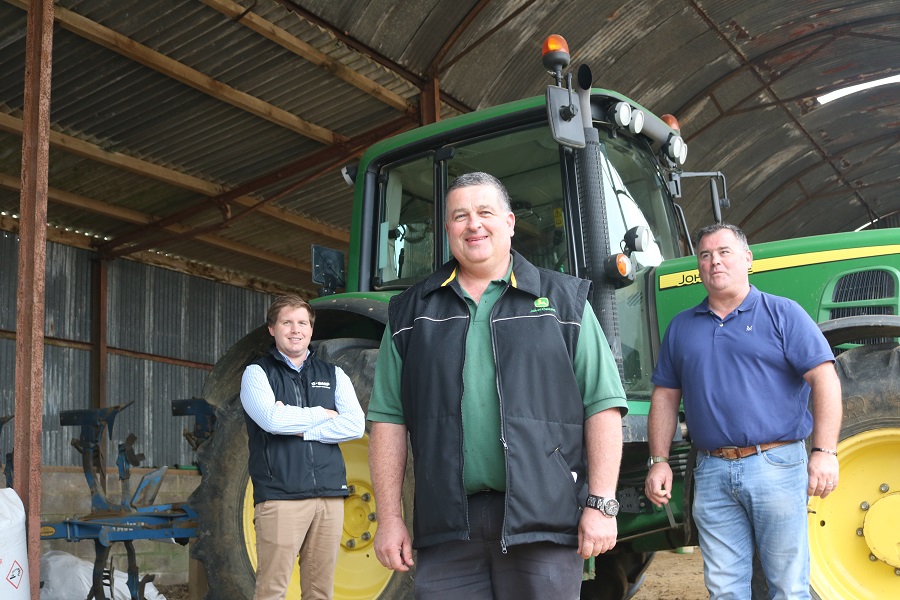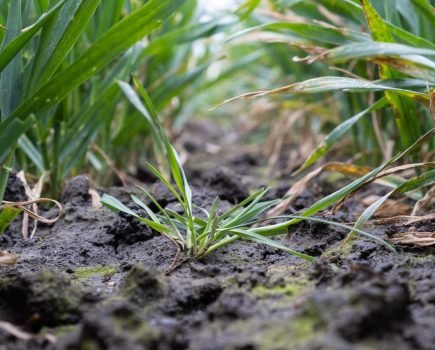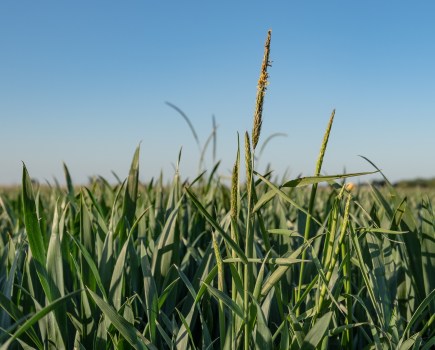For 30 years, a farm in Somerset has carried out on-farm trials to find dependable varieties and fungicide programmes. CPM visits to find the same approach is now being applied to decision support tools.
When a genuine step-up in chemistry comes along, you see the difference in our trials, and Revysol doesn’t disappoint.
By Tom Allen-Stevens
While some farmers will try a new approach along the odd tramline, Somerset grower Mark Doble takes his on-farm trials quite a few steps further.
For the past 30 years, he’s trialled a number of varieties side-by-side on undulating land that varies from sand to sand/clay brash at Hurcott Farm, near Ilminster. Each year more than 12 wheat varieties are drilled across the tramlines of a field so he can put a whole host of fungicide treatments to the test along each one.
“As well as the farm standard programme and untreated, we have the SDHI-based programmes from all the leading manufacturers, with and without chlorothalonil (CTL) and we’re also looking at the effect of biostimulants and varying the T3 spray application,” he explains.
Sprays applied to the trial field are made with the 4m sections of his Knight 24m demount sprayer. “You do need a full day and absolutely no distractions when it comes to applying the different treatments to make sure you get it right. It also takes a fastidious attention to detail.”
You get the impression there’s no shortage of that across the 160ha he farms. Winter wheat, winter barley, oilseed rape, maize and spring beans are the main crops in the rotation, with potatoes and some winter linseed – almost all grown for seed. “We recently took on two fields that have blackgrass which have been kept in a wholecrop winter wheat and maize rotation for a local anaerobic digester until they’re clean enough for seed crops,” he says.
Over the years, the trials have developed and become something of a local attraction. More recently, the farm has hosted regional trials for BASF and Agrovista, including an additional 32 variety plots for an open day that usually takes place in June. “It’s become a bit of a mini-Cereals event,” notes Mark. “As well as the wheat plots we have soil pits, an AHDB stand, seed breeders, tyre experts, rural crime advisers and there’s usually over 100 local farmers who turn up.”
It’s the trials themselves that are the main draw, however. “In this part of the world it’s all about septoria – growers in this area get precious little good local information on what different varieties and treatments will do. It’s why we started doing them in the first place.”
Although focused on local priorities, these are now getting national attention – over the past three years, Mark’s picked up two bronze and three gold YEN awards for his trials in both overall yield and highest percentage of potential yield – output from the trials is harvested carefully and taken over a local weighbridge. “We got a 16t/ha crop of Reflection in 2016 – somewhat better than the gold awards in that year, so thought we’d give it a go.”
So what’s he learned? “What I look for are two or three varieties to consider taking over a wider area – this year we’re giving KWS Cranium a go, for instance. And there’s nothing like having your own trials to see for yourself how the newer chemistry performs under your own management and conditions.
“Generally the trials have always shown the more you spend, the greater the return – in 2016 the difference between best treated and worst untreated was 10.69t/ha, for instance. The cleaner varieties buy you time and flexibility, but still benefit from a robust spray programme. KWS Extase, for example, is higher yielding in the untreated plots and early maturing, but still pays to be sprayed.”
For the past three years, he’s been taking a look at Revysol (mefentrifluconazole), the new triazole from BASF. “When a genuine step-up in chemistry comes along, you see the difference in our trials, and Revysol doesn’t disappoint,” he says.
“It’s stand-out different, keeping the whole plant greener, and now forms the basis of our farm-standard T2 application – it kept the majority of the yield intact on the wheat in this poor harvest year.” Revysol and Xemium (fluxapyroxad) have been partnered with pyraclostrobin on farm, with average yields around the 12-13t/ha mark.
“But what I have noticed in recent years is a notable change in weather patterns. You get fewer opportunities to spray, and weather comes in prolonged blocks. I can see the emphasis in the future will be less about what we spray, and more about being better informed on how we apply it,” he notes.
The varieties and programmes put on trial are decided by Mark, along with his Agrovista agronomist and BASF regional agronomy manager Richard Guest. Richard and field sales manager Paul Haynes from BASF have come to the farm for a socially distanced meeting. But the topic under discussion is a quite different trial that’s taken place at Hurcott for the first time this year.
“For several years we’ve been ground-truthing xarvio Field Manager,” explains Richard. “This is a web and smartphone app-based crop production optimisation system, designed to help growers make the right decision on when and how to treat their crops. The smart algorithms that do the number crunching are like a sponge for information – the more you feed them, the better they become.”
So Richard and his colleagues have been regularly checking growth stages and disease levels across the 32 variety plots BASF have at Hurcott Farm and other sites around the UK, feeding this back to xarvio. “This inevitably sparked Mark’s interest. He saw a presentation on the service and we decided to take part in a trial this year.”
Mark confesses he’s no computer natural, with crop records all paper-based, but found xarvio Field Manager surprisingly easy to set up. “We’ve been variably applying fertiliser for some time and now that I have GPS auto-shutoff on the sprayer, it seemed logical to explore variable application with crop protection inputs too, so I downloaded the maps from this to set it up. Field Manager allows you to keep basic records on applications, but it’s the Spray Timer module I’m most comfortable with so far.
“Having seen three years of ground-truthing here and working closely with BASF I knew to trust the algorithms, but I was shocked at just how much faith I put in it. I found myself extrapolating growth stage results and basing applications on timings predicted by xarvio. The thing is, it was spot on, and I’m a stickler for detail,” he says.
For Mark, using the Spray Zone module to apply as much chemical as the crop warranted made sense, especially in a year of such variability. “I’d like to try it over a larger area and see how it performed in a more normal season, although I’m not sure we have normal seasons any more – we’re moving to a climate of extremes, which is why I think traditional spray schedules may need a rethink.”
Richard agrees. “In this challenging season, we’ve been impressed to see how accurately Spray Timer has predicted the development of crop growth and disease alongside the agronomist. It’s reassuring to see how technology can optimise activities on farm, supporting both agronomist and grower alike.
“The use of VRA with Zone Spray will help improve efficiency on farm by applying the crop protection product at the right rate, where it’s most needed within the field,” adds Richard.
xarvio approaches its first UK anniversary
Following its launch across the UK as a full commercial package at LAMMA 2020, 1100 new users have joined xarvio Field Manager. In total, it’s used across Europe and the Americas on around 30,000 farms and is the second in a suite of digital tools from the company, following the launch of smartphone-based Scouting last year.
It’s presented in three modules:
- Field Monitor pulls satellite imagery into your dashboard during the season to give you an idea of biomass cover, now based on leaf area index (LAI), claimed to offer less data saturation than the standard NDVI to show up differences better. You can upload other field zone maps, data from a weather station and import files from MyJohnDeere.
- Spray Timer is a field-specific service that forecasts growth stage, based on crop variety, drilling date, N applications, etc, models disease and insect risk, and optimises forecasts via observations. It puts it all through clever algorithms to advise on if, and when to spray to protect your crop most efficiently. The neat bit is that it factors in what field management tasks you’ve already performed, while a traffic-light system indicates when you need to get the sprayer out, and special symbols help you prioritise jobs.
- Zone Spray makes use of the LAI biomass maps and gives you a variable-rate application (VRA) map, allowing you to adjust fungicide and/or growth regulator (by applied water volume) based on crop cover. Safeguards within the module ensure statutory label rates and concentrations are not compromised. Compatible with all standard terminals, VRA maps can be transferred using a USB drive or exported via MyJohnDeere and agrirouter.
Since its launch, a new function in Field Manager is the ability to ‘Share My Farm’, that allows access to your agronomist, spray contractor or other third party while you control what they view.
On-farm trials get the Real Results on xarvio
Although this was xarvio’s first commercial season with Field Manager, it was evaluated by 14 growers last season, notes xarvio agronomist Anna Crockford, who’s been co-ordinating the farmer triallists.
“It’s been a very challenging year with variable crops racing through growth stages, while COVID-19 has restricted our ability to get on farm and monitor the crop throughout the season. But the feedback we’ve received from growers and agronomists is that Spray Timer has correctly predicted growth stages in most cases, despite the difficult season. We’re seeing a distinct year-on-year improvement in how the algorithms perform,” she reports.
During 2020, there have been 14 growers carrying out VRA trials, from Fife in Scotland to Kent in south east England. “Most trials varied both the T1 and T2 sprays along tramlines in a field, comparing results with a flat rate applied across the rest of the field.”
At Hurcott Farm, just the T2 spray was varied over Bonnings 2, a 5.7ha field of KWS Kinetic winter wheat drilled on 21 Oct. In line with other Real Results trials, yield data from the combine was taken and results compared applying the Agronomics approach from ADAS, which uses spatial modelling and statistics to ensure scientific rigour.
The spray programme started with a T0 spray of epoxiconazole, metrafenone and CTL on 1 April followed by a repeat dose with boscalid and pyraclostrobin at the T1 timing (23 April). The T2 was sprayed on 15 May and consisted of pyraclostrobin, Xemium and Revysol with CTL. All treatments were applied at a water volume of 250 l/ha, while in the VRA tramlines at T2, this was varied from 225-300 l/ha.
Slug damage caused a large area of much thinner crop towards the northern edge of the field, but LAI maps indicated generally high biomass, especially in the eastern half. During data cleaning, the ADAS Agronomics methodology removed this area for a more comparable assessment. The effect of the VRA treatment increased yield by 0.18t/ha, according to the ADAS analysis, but a yield difference would have to exceed 0.37t/ha to be deemed statistically significant at the 95% confidence level.
“Overall it’s a positive story,” concludes Anna. “The 0.18t/ha yield increase where VRA was applied resulted in Mark achieving a £24/ha benefit over the flat rate input. We will continue our trials with growers and agronomists across the UK to build a more comprehensive picture.”
The Real Results Circle
BASF’s Real Results Circle farmer-led trials are now in their fourth year. The initiative is focused on working with 50 farmers to conduct field-scale trials on their own farms using their own kit and management systems. The trials are all assessed using ADAS’ Agronomics tool which delivers statistical confidence to tramline, or field-wide treatment comparisons – an important part of Real Results.
In this series we follow the journey, thinking and results from farmers involved in the programme. The features also look at some in-depth related topics, such as SDHI performance and data capture and use.
We want farmers to share their knowledge and conduct on-farm trials. By coming together to face challenges as one, we can find out what really works and shape the future of UK agriculture.
To keep in touch with the progress of these growers and the trials, go to www.basfrealresults.co.uk




